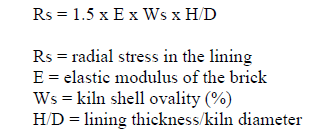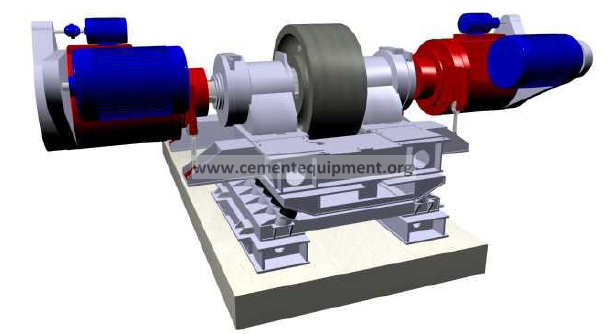Contents
REFRACTORY THICKNESS IN ROTARY KILN
[wpecpp name=”package + Updates forever” price=”250″ align=”center”]
LINING THICKNESS
INTRODUCTION
The ideal lining thickness for a rotary kiln has always been a matter of controversy. As a matter of fact, there are very large kilns lined with 200mm brick and small kilns lined with 220mm brick. The goal of this paper is to discuss the subject under the light of science.
PRESENT SITUATION
The lining thickness used by most cement and lime plants is usually the original prescribed by the kiln manufacturer. Below is an example of a typical table published by a traditional refractory supplier.

Some interesting conclusions can be driven from this table:
– The ratio between lining thickness and kiln diameter varies between 3.5% and 6%, therefore being far from proportional.
– The 160 mm lining thickness, a standard metric ISO or VDZ brick is not shown.
According to the table, lining a 3048 mm kiln with a 180 mm brick is as acceptable as lining a 7010 mm kiln with a 250 mm brick. Will the mechanical and thermal stresses be the same for both situations?
SOME SCIENCE ON THE MATTER
It is also a well-known fact that the ratio between the lining thickness and the kiln diameter cannot be a continuous function, otherwise, it would require dozens of brick sizes to supply the entire kiln diameter range in the market.
Many other factors, besides the kiln diameter, should be taken into consideration when choosing a lining thickness:
– The rigidity of the kiln shell, defined by its thickness. Thicker shells obviously flex less than thinner shells, for the same temperature and alloy. A flexible shell, with high ovality, poses compressive stresses on thick linings and a higher risk of brick detachment on thinner linings.
– The rigidity of the kiln shell in temperatures above 350 ºC. Since metal strength decreases with temperature, a hot shell yields more under load than a cold shell.
– The distance between supporting piers. The larger the shell span, the larger the shell deformation.
– The ovality of the kiln shell. To a larger ovality corresponds a larger radial stress on the lining.
– The thermal conductivity of the brick. The thermal conductivity controls the heat flow and the temperature gradient inside the lining. Thicker bricks with lower thermal conductivity are more prone to spalling than thinner bricks with higher thermal conductivity.
The relationship between lining thickness and radial stress on the lining is given by:

Other factors remaining constant, increasing the lining thickness will increase the radial stress on the lining. Another important conclusion from the previous mathematical relationship is that the radial stress is higher for small kilns than for large kilns.
Therefore, larger kilns should have fewer problems with thick linings than smaller kilns. In its “Practical Guide for Refractories” Holderbank unequivocally states: “In practice it has been found that by increasing the lining thickness in basic-lined zones only a very minor and therefore unprofitable increase in lining service life can be attained.”
This statement is particularly true for basic brick in the upper-transition/burning zone interface in cement kilns, where the shell is at maximum ovality, hot, and the lining is frequently stressed by clinker melt and alkali infiltration and spalling. Increasing the lining thickness under such circumstances will not increase brick life. As a matter of fact, it could reduce it significantly due to the higher mean temperature inside the brick and the larger thermal gradient. In other kiln areas where abrasion is the only wear factor, increasing the lining thickness will increase lining duration. In such cases the lining should be fully mortared in place to minimize pinching stress or capping. In warped areas of the kiln shell and under tires in particular, decreasing the lining thickness could improve brick life.
How does the change in lining thickness impact shell temperature? Increasing the lining thickness from 200mm to 250mm, for a process temperature of 1400C, changes the shell temperature from 434C to 415C. Not enough to justify the investment; besides, the increase in lining weight is 25%. Cost is another factor to be taken into consideration. By switching from a 200 mm to a 250 mm brick, for example, the price per lining meter goes up by 25% as well.
In the absence of excessive shell ovality and kiln misalignment, a thicker lining can increase brick life in any zone. If the wear mechanism is related to alkali infiltration and brick spalling, a thicker and less permeable brick can definitely improve refractory performance. Extra care should be taken during the installation of thick linings. Mortar should be used in place of correction shims to avoid the creation of point loads.
